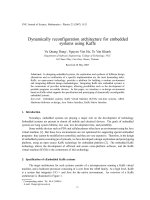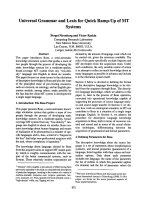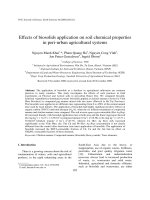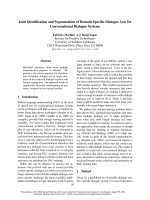Economic systems.doc
Bạn đang xem bản rút gọn của tài liệu. Xem và tải ngay bản đầy đủ của tài liệu tại đây (99.2 KB, 13 trang )
I. ECONOMIC SYSTEMS
1. Definitions
An economic system is the system of production, distribution and consumption
of goods and services of an economy. Alternatively, it is the set of principles and
techniques by which problems of economics are addressed, such as the economic
problem of scarcity through allocation of finite productive resources
The econonic system is composed of people and institutions, including their
relationships to productive resources, such as through the convention of property.
Examples of contemporary economic systems include capitalist systems, socialist
systems, and mixed economies. "Economic systems" is the economics category that
includes the study of respective systems. Currently capitalist system is the world's
most dominant form of economic system.
An economic system can be defined as a "set of methods and standards by which
a society decides and organizes the allocation of limited economic resources to
satisfy unlimited human wants. At one extreme, production is carried in a private-
enterprise system such that all resources are privately owned. It was described by
Adam Smith as frequently promoting a social interest, although only a private
interest was intended. At the other extreme, following Karl Marx and Vladimir
Lenin is what is commonly called a pure-communist system, such that all resources
are publicly owned with intent of minimizing inequalities of wealth among other
social objectives".
2. Type of Economic System
Three types of economic systems exist, each with their own drawbacks and
benefits; the Market Economy, the Planned Economy and the Mixed Economy.
An economic system is loosely defined as country’s plan for its services, goods
produced, and the exact way in which its economic plan is carried out. In general,
there are three major types of economic systems prevailing around the world.
2.1 Market Economy
In a market economy, national and state governments play a minor role. Instead,
consumers and their buying decisions drive the economy. In this type of economic
system, the assumptions of the market play a major role in deciding the right path
for a country’s economic development.
Market economies aim to reduce or eliminate entirely subsidies for a particular
industry, the pre-determination of prices for different commodities, and the amount
of regulation controlling different industrial sectors.
The absence of central planning is one of the major features of this economic
system. Market decisions are mainly dominated by supply and demand. The role of
the government in a market economy is to simply make sure that the market is stable
enough to carry out its economic activities
2.2 Planned Economy
A planned economy is also sometimes called a command economy. The most
important aspect of this type of economy is that all major decisions related to the
production, distribution, commodity and service prices, are all made by the
government.
The planned economy is government directed, and market forces have very little say
in such an economy. This type of economy lacks the kind of flexibility that is
present a market economy, and because of this, the planned economy reacts slower
to changes in consumer needs and fluctuating patterns of supply and demand.
On the other hand, a planned economy aims at using all available resources for
developing production instead of allotting the resources for advertising or
marketing.
2.3 Mixed Economy
A mixed economy combines elements of both the planned and the market
economies in one cohesive system. This means that certain features from both
market and planned economic systems are taken to form this type of economy. This
system prevails in many countries where neither the government nor the business
entities control the economic activities of that country - both sectors play an
important role in the economic decision-making of the country. In a mixed economy
there is flexibility in some areas and government control in others. Mixed
economies include both capitalist and socialist economic policies and often arise in
societies that seek to balance a wide range of political and economic views.
II. SUPPLY AND DEMAND
Supply and demand is an economic model of price determination in a market. It
concludes that in a competitive market, the unit price for a particular good will vary
until it settles at a point where the quantity demanded by consumers (at current
price) will equal the quantity supplied by producers (at current price), resulting in an
economic equilibrium of price and quantity.
Supply is the amount of product that a producer is willing and able to sell at a
specified price, while demand is the amount of product that a buyer is willing and
able to buy at a specified price. Thus, the supply and demand model shows the
relationships between a product’s accessibility and the interest shown in it. Unlike
with general equilibrium models, however, this model does not define the attributes
that are responsible for supply schedules
Supply
Supply is The quatity of a good sellers wish to sell at each convervable price.
Supply is not a particular quantity but a complet description of the quatity that
sellers wouls like to sell at each and every possible price.
Law of Supply
As the price of a product rises, ceteris paribus, suppliers will offer more for sale.
This implies that price and quantity supplied are positively related. The major factor
that influences supply is the "cost of production", and includes:
1. Input prices - As the prices of inputs such as labour, raw materials, and
capital increase, production tends to be less profitable, and less will be
produced. This leads to a decrease in supply.
2. Technology - Technology relates to methods of transforming inputs into
outputs. Improvements in technology will reduce the costs of production and
make sales more profitable so it tends to increase the supply.
3. Expectations - If firms expect prices to rise in the future, may try to product
less now and more later.
Supply Curves and Schedules
The relationship between the price of a product and the quantity supplied, holding
all other things constant is generally sloping upwards. Supply is represented by the
entire curve and not just one point on the curve. When the price of the product
changes, the quantity supplied changes, but supply does not change. When cost of
production changes, supply changes, and the entire supply curve will shift.
Market Supply is the summation of all the individual supply curves, and is the
horizontal sum of individual supply curves. It is influenced by the factors that
determine individual supply curves, such as cost of production, plus the number of
suppliers in the market. In general, the more firms producing a product, the greater
the market supply.
When quantity supplied at a given price decreases, the whole curve shifts to the left
as there is a decrease in supply. This is generally caused by an increase in the cost of
production or decrease in the number of sellers. An increase in wages, cost of raw
materials, cost of capital, ceteris paribus, will decrease supply. Sometimes weather
may also affect supply, if the raw materials are perishable or unattainable due to
transportation problems.
Demand
Demand is the quantity of a good buyers wish to purchase at each conceivable
price. Thus demand is not a particular quantity, such as six bars of chocolates, but
rather a full description of the quantity of chocolate the buyer would purchase at
each and every price which might be charged.
Law of Demand
The Law of Demand states that other things held constant, as the price of a good
increases, the quantity demanded will fall. Other factors that can influence demand
include:
1. Income - Generally, as income increases, we are able to buy more of most
goods. When demand for a good increases when incomes increase, we call
that good a "normal good". When demand for a good decreases when
incomes increase, then that good is called an inferior good.
2. Price of related products - Related goods come in two types, the first of
which are "substitutes". Substitutes are similar products that can be used as
alternatives. Examples of substitute goods are Coke/Pepsi, and
butter/margarine. Usually, people substitute away to the less expensive good.
Other related products are classified as "complements". Complements are









